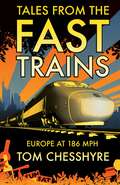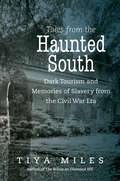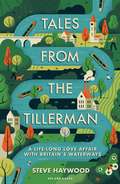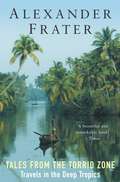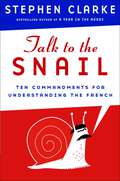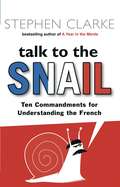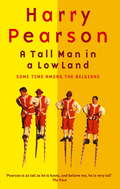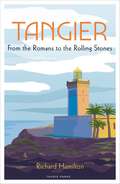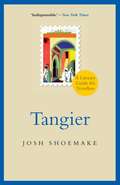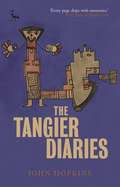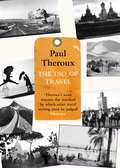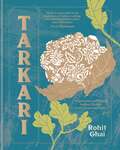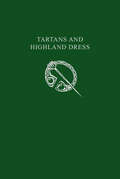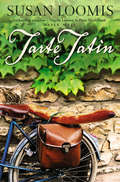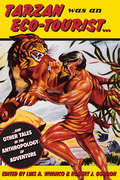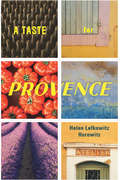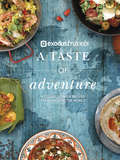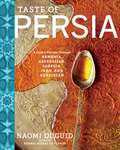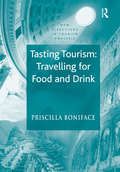- Table View
- List View
Tales from the Fast Trains: Around Europe at 186mph
by Tom ChesshyreTired of airport queues and delays, Tom Chesshyre embarks on a series of high-speed adventures across the Continent on its fast trains instead. He travels to places that wouldn’t feature on a standard holiday wish-list and discovers the hidden delights of mysterious Luxembourg, super-trendy Rotterdam and much-maligned Frankfurt.
Tales from the Haunted South: Dark Tourism and Memories of Slavery from the Civil War Era (The Steven and Janice Brose Lectures in the Civil War Era)
by Tiya MilesIn this book Tiya Miles explores the popular yet troubling phenomenon of "ghost tours," frequently promoted and experienced at plantations, urban manor homes, and cemeteries throughout the South. As a staple of the tours, guides entertain paying customers by routinely relying on stories of enslaved black specters. But who are these ghosts? Examining popular sites and stories from these tours, Miles shows that haunted tales routinely appropriate and skew African American history to produce representations of slavery for commercial gain. "Dark tourism" often highlights the most sensationalist and macabre aspects of slavery, from salacious sexual ties between white masters and black women slaves to the physical abuse and torture of black bodies to the supposedly exotic nature of African spiritual practices. Because the realities of slavery are largely absent from these tours, Miles reveals how they continue to feed problematic "Old South" narratives and erase the hard truths of the Civil War era. In an incisive and engaging work, Miles uses these troubling cases to shine light on how we feel about the Civil War and race, and how the ghosts of the past are still with us.
Tales from the Tillerman: A Life-long Love Affair with Britain's Waterways
by Steve Haywood'Haywood imprints his inimitable humour on his descriptions of the people and places he meets along the way.' – BBC Countryfile magazine'He conjures up a picture of a different world, filled with interesting and eccentric people. A cross-section of the best of middle England, in fact.' – The Oxford TimesSteve Haywood has been cruising the inland waterways for fifty years, and has amassed a following of readers keen to hear about his travelling tales on Britain's beautiful canals and rivers. His previously published books – Narrowboat Dreams, One Man and a Narrowboat, Too Narrow to Swing a Cat and Narrowboat Nomads – have all been hugely enjoyed by those with a desire for a narrowboat narrative told in Steve's witty, charming style.Tales from the Tillerman is Steve's next title and is both his tribute to Britain's canals, rivers and countryside and a celebration of Britishness in all its eccentric glory. Unlike Steve's previous titles, which have each focussed on one particular journey that Steve has taken, Tales from the Tillerman is casting the net wider and drawing from his full fifty years of experience, recounting the many hair-raising escapades he's had up and down the country and reflecting on how the country and the cruising landscape has changed in those fifty years.Anecdotes and light-hearted rants aplenty, mixed with some tall tales and a smattering of the nostalgic, in Tales from the Tillerman you'll be thoroughly entertained as a middle-aged man (oh, go on then, an old one) reflects on his long love affair with boats and waterways, contemplating their importance to his life and how they've changed it.
Tales from the Tillerman: A Life-long Love Affair with Britain's Waterways
by Steve Haywood'Haywood imprints his inimitable humour on his descriptions of the people and places he meets along the way.' – BBC Countryfile magazine'He conjures up a picture of a different world, filled with interesting and eccentric people. A cross-section of the best of middle England, in fact.' – The Oxford TimesSteve Haywood has been cruising the inland waterways for fifty years, and has amassed a following of readers keen to hear about his travelling tales on Britain's beautiful canals and rivers. His previously published books – Narrowboat Dreams, One Man and a Narrowboat, Too Narrow to Swing a Cat and Narrowboat Nomads – have all been hugely enjoyed by those with a desire for a narrowboat narrative told in Steve's witty, charming style.Tales from the Tillerman is Steve's next title and is both his tribute to Britain's canals, rivers and countryside and a celebration of Britishness in all its eccentric glory. Unlike Steve's previous titles, which have each focussed on one particular journey that Steve has taken, Tales from the Tillerman is casting the net wider and drawing from his full fifty years of experience, recounting the many hair-raising escapades he's had up and down the country and reflecting on how the country and the cruising landscape has changed in those fifty years.Anecdotes and light-hearted rants aplenty, mixed with some tall tales and a smattering of the nostalgic, in Tales from the Tillerman you'll be thoroughly entertained as a middle-aged man (oh, go on then, an old one) reflects on his long love affair with boats and waterways, contemplating their importance to his life and how they've changed it.
Tales from the Torrid Zone: Travels in the Deep Tropics (Vintage Departures Ser.)
by Alexander FraterPart memoir, part travelogue, Tales From the Torrid Zone is rooted in Alex Frater's birthplace, the tiny tropical republic of Vanuatu where his father ran its hospital and his mother, in her front garden, built its first school. From this obscure South Seas group he ranges over the hot, wet, beautiful swathe of the world that has haunted him ever since – dines with a tropical queen in a leper colony, makes his way across tropical Africa (and two civil wars) in a forty-four-year-old flying boat, delivers a new church bell to a remote Oceanian island and visits scores of countries to learn about their history, politics, medicine, flora and fauna (including the remarkable role of the coconut in tropical life). But, as becomes plain, the torrid zone is not just a geographical phenomenon, it’s also a state of mind. The result is a witty, entertaining and immensely readable book from a fine storyteller.
Talk to the Snail: Ten Commandments for Understanding the French
by Stephen ClarkeHave you ever walked into a half-empty Parisian restaurant, only to be told that it's "complet"? Attempted to say "merci beaucoup" and accidentally complimented someone's physique? Been overlooked at the boulangerie due to your adherence to the bizarre foreign custom of waiting in line? Well, you're not alone. The internationally bestselling author of A Year in the Merde and In the Merde for Love has been there too, and he is here to help. In Talk to the Snail, Stephen Clarke distills the fruits of years spent in the French trenches into a truly handy (and hilarious) book of advice. Read this book, and find out how to get good service from the grumpiest waiter; be exquisitely polite and brutally rude at the same time; and employ the language of l'amour and le sexe. Everything you need is here in this funny, informative, and seriously useful guide to getting what you really want from the French.
Talk to the Snail: Ten Commandments For Understanding The French
by Stephen ClarkeHave you been taken to what you've been assured is the perfect house deep in the French countryside, only to find there's no electricity or running water? Gone to the doctor with a nasty cough, and been diagnosed with a rather more personal complaint? Walked into an half-empty restaurant, only to be told that it's complet?If the answer to any of the above is oui, Talk to the Snail is the book for you.Find out how to get served in a restaurant; the best way to deal with French hypochondria; learn the language of love, sex and suppositories (not necessarily in that order); it's all here in this funny, informative, seriously useful guide on how to get what you really want from the French.With advice on essential phrases and bons mots to cover all eventualities, and illustrated with witty real-life anecdotes, Talk to the Snail is a book that no self-respecting Francophile - or Francophobe - can afford to be without.Don't go to France without reading this book.And don't even think of buying a house there.
A Tall Man In A Low Land: Some Time Among the Belgians
by Harry PearsonMost British travel writers head south for a destination that is hot, exotic, dangerous or all three. Harry Pearson chose to head in the opposite direction for a country which is damp, safe and of legendary banality: Belgium. But can any nation whose most famous monument is a statue of a small boy urinating really be that dull? Pearson lived there for several months, burying himself in the local culture. He drank many of the 800 different beers the Belgians produce; ate local delicacies such as kip kap (jellied pig cheeks) and a mighty tonnage of chicory and chips. In one restaurant the house speciality was 'Hare in the style of grandmother'. 'I didn't order it. I quite like hare, but had no wish to see one wearing zip-up boots and a blue beret.' A TALL MAN IN A LOW LAND commemorates strange events such as The Festival of Shrimps at Oostduinkerke and laments the passing of the Underpant Museum in Brussels. No reader will go away from A TALL MAN IN A LOW LAND without being able to name at least ten famous Belgians. Mixing evocative description and low-grade buffoonery Harry Pearson paints a portrait of Belgium that is more rounded than a Smurf after a night on the mussels.
Tangier: From the Romans to The Rolling Stones
by Richard HamiltonIn Tangier, the Moroccan novelist Mohamed Choukri wrote, 'everything is surreal and everything is possible.' In this intimate portrait of a city, the former BBC North Africa correspondent, Richard Hamilton, explores its hotels, cafés, alleyways and darkest secrets to find out what it is that has inspired so many international writers, artists and musicians. Delving down through complex historical layers, he finds a frontier town that is comic, confounding and haunted by the ghosts of its past. Samuel Pepys thought God should destroy Tangier and St Francis of Assisi called it a city of 'madness and delusions.' Yet, throughout the centuries, it has also been a crucible of creativity. It was a turning point in Henri Matisse's artistic journey and had a profound impact on the founder of the Rolling Stones, Brian Jones. Tangier also produced two of the greatest American novels of the twentieth century: The Sheltering Skyand Naked Lunch. Besides Paul Bowles and William Burroughs, the book also looks at lesser known characters such as the flawed genius, Brion Gysin, as well as Ibn Battuta, who travelled three times further than Marco Polo. Featuring a thrilling cast of pirates, sultans, artists, musicians, writers, princes and playboys, this is an essential read about Tangier.
Tangier: A Literary Guide for Travellers (Literary Guides for Travellers #2)
by Josh ShoemakeAn edge city, poised at the northernmost tip of Africa, just nine miles across the Strait of Gibraltar from Europe and overlooking both the Mediterranean and the Atlantic, Tangier is more than a destination, it is an escape, and the Interzone, as William Burroughs called it, has attracted spies, outlaws, outcasts and writers for centuries – men and women working out at the edge of literary forms, breaking through artistic borders. This outlaw originality is what most astonishes when encountering the literary history of Tangier for the first time. Particularly in the past century, the results were some of the most incendiary and influential books of our time, the most prominent being Burroughs' Naked Lunch and Paul Bowles' The Sheltering Sky. The list of "edge" writers who were drawn to Tangier is long, among them Ibn Battuta, Samuel Pepys, Alexandre Dumas, Mark Twain, Edith Wharton, Walter Harris, Jean Genet, Paul and Jane Bowles, Tennessee Williams, William Burroughs, Brion Gysin, Patricia Highsmith, Jack Kerouac, Truman Capote, Gore Vidal, Allen Ginsberg, Alfred Chester, Joe Orton, and Mohamed Choukri.This enthralling book captures the unconventional, multilayered story of literary Tangier and is a must-have for travellers, armchair adventurers and literature buffs, particularly aficionados of the Beat generation writers and poets who made the city their home.
The Tangier Diaries (The\i. B. Tauris Literary Guides For Travelers Ser.)
by John HopkinsTangier in the 1960s and '70s was a fabled place. This edge city, the 'Interzone', became muse and escapist's dream for artists, writers, millionaires and socialites, who wrote, painted, partied and experienced life with an intensity and freedom that they never could back home. Into this louche and cosmopolitan world came John Hopkins, a young writer who became a part of the bohemian Tangier crowd with its core of Beats that included William Burroughs, Paul and Jane Bowles and Brion Gysin, as well as Tennessee Williams, Jean Genet, Yves Saint Laurent, Barbara Hutton and Malcolm Forbes. Those intoxicating decades - Tangier's 'Golden Years' - are long gone. Grand old houses that once sparkled with life are shuttered and dark and most of the eccentrics who once lived and loved in the city have died. But here, in the pages of John Hopkins' cult classic, all the decadence and flamboyance of those days is brought to life once more.
The Tao of Travel: Enlightenments From Lives On The Road
by Paul TherouxPaul Theroux celebrates fifty years of wandering the globe by collecting the best writing on travel from the books that shaped him, as a reader and a traveller. Part philosophical guide, part miscellany, part reminiscence, The Tao of Travel enumerates 'The Contents of Some Travellers' Bags' and exposes 'Writers Who Wrote About Places They Never Visited'; tracks extreme journeys in 'Travel As An Ordeal' and highlights some of 'Travellers' Favourite Places'. Excerpts from the best of Theroux's own work are interspersed with selections from travellers both familiar and unexpected, including Vladimir Nabokov, Henry David Thoreau, Graham Greene, Ernest Hemingway and more. The Tao of Travel is a unique tribute to the pleasures and pains of travel in its golden age.
Tarkari: Vegetarian and Vegan Indian Dishes with Heart and Soul
by Rohit Ghai'Rohit is respectful of the traditions of Indian cooking, yet unafraid of innovation and refinement.' - Pierre KoffmannWith food inspired by India's incredibly rich and varied food scene, Rohit Ghai has gained a reputation for colourful, flavour-rich curries that showcase both classic and lesser-known Indian flavours. Tarkari, meaning 'vegetable' in Urdu, is Rohit's first book and similarly celebrates this diverse heritage - but on a more personal, homely note.Packed with innovative vegetarian and vegan dishes, it pays homage to the food his parents ate. From creative starters like Malabar Cauliflower, to big, bold curries such as Jackfruit Masala and Lotus Root Kofta, as well as breads, rice, dips and pickles, it includes everything you need to cook truly spectacular Indian vegetarian and vegan meals at home.'Rohit Ghai's backstory is the stuff of culinary legend.' GQ'Faultless cooking that has immediately propelled it into London's very top tier for nouvelle cuisine.' Harden's London Restaurant Guide on Kutir
Tartans & Highland Dress (Collins Scottish Archive)
by CollinsA small format gift book which is a reproduction of the popular Collins book ‘Tartans & Highland Dress’ published in 1961. This is a detailed guide to how to correctly wear the Scottish national dress along with profiles of the main tartans.
Tarte Tatin: More Of La Belle Vie On Rue Tatin
by Susan LoomisFurther adventures on life in a small French town from Susan Loomis, cookery book writer and author of ‘On Rue Tatin’.
Tarzan Was an Eco-tourist: ...and Other Tales in the Anthropology of Adventure
by Luis Vivanco Robert J. GordonAdventure is currently enjoying enormous interest in public culture. The image of Tarzan provides a rewarding lens through which to explore this phenomenon. In their day, Edgar Rice Burrough’s novels enjoyed great popularity because Tarzan represented the consummate colonial-era adventurer: a white man whose noble civility enabled him to communicate with and control savage peoples and animals. The contemporary Tarzan of movies and cartoons is in many ways just as popular, but carries different connotations. Tarzan is now the consummate “eco-tourist:” a cosmopolitan striving to live in harmony with nature, using appropriate technology, and helpful to the natives who cannot seem to solve their own problems. Tarzan is still an icon of adventure, because like all adventurers, his actions have universal qualities: doing something previously untried, revealing the previously undiscovered, and experiencing the unadulterated. Prominent anthropologists have come together in this volume to reflect on various aspects of this phenomenon and to discuss contemporary forms of adventure.
A Taste for Provence
by Helen Lefkowitz HorowitzProvence today is a state of mind as much as a region of France, promising clear skies and bright sun, gentle breezes scented with lavender and wild herbs, scenery alternately bold and intricate, and delicious foods served alongside heady wines. Yet in the mid-twentieth century, a travel guide called the region a “mostly dry, scrubby, rocky, arid land.” How, then, did Provence become a land of desire—an alluring landscape for the American holiday? In A Taste for Provence, historian Helen Lefkowitz Horowitz digs into this question and spins a wonderfully appealing tale of how Provence became Provence. The region had previously been regarded as a backwater and known only for its Roman ruins, but in the postwar era authors, chefs, food writers, visual artists, purveyors of goods, and travel magazines crafted a new, alluring image for Provence. Soon, the travel industry learned that there were many ways to roam—and some even involved sitting still. The promise of longer stays where one cooked fresh food from storied outdoor markets became desirable as American travelers sought new tastes and unadulterated ingredients. Even as she revels in its atmospheric, cultural, and culinary attractions, Horowitz demystifies Provence and the perpetuation of its image today. Guiding readers through books, magazines, and cookbooks, she takes us on a tour of Provence pitched as a new Eden, and she dives into the records of a wide range of visual media—paintings, photographs, television, and film—demonstrating what fueled American enthusiasm for the region. Beginning in the 1970s, Provence—for a summer, a month, or even just a week or two—became a dream for many Americans. Even today as a road well traveled, Provence continues to enchant travelers, armchair and actual alike.
A Taste for Provence
by Helen Lefkowitz HorowitzProvence today is a state of mind as much as a region of France, promising clear skies and bright sun, gentle breezes scented with lavender and wild herbs, scenery alternately bold and intricate, and delicious foods served alongside heady wines. Yet in the mid-twentieth century, a travel guide called the region a “mostly dry, scrubby, rocky, arid land.” How, then, did Provence become a land of desire—an alluring landscape for the American holiday? In A Taste for Provence, historian Helen Lefkowitz Horowitz digs into this question and spins a wonderfully appealing tale of how Provence became Provence. The region had previously been regarded as a backwater and known only for its Roman ruins, but in the postwar era authors, chefs, food writers, visual artists, purveyors of goods, and travel magazines crafted a new, alluring image for Provence. Soon, the travel industry learned that there were many ways to roam—and some even involved sitting still. The promise of longer stays where one cooked fresh food from storied outdoor markets became desirable as American travelers sought new tastes and unadulterated ingredients. Even as she revels in its atmospheric, cultural, and culinary attractions, Horowitz demystifies Provence and the perpetuation of its image today. Guiding readers through books, magazines, and cookbooks, she takes us on a tour of Provence pitched as a new Eden, and she dives into the records of a wide range of visual media—paintings, photographs, television, and film—demonstrating what fueled American enthusiasm for the region. Beginning in the 1970s, Provence—for a summer, a month, or even just a week or two—became a dream for many Americans. Even today as a road well traveled, Provence continues to enchant travelers, armchair and actual alike.
A Taste for Provence
by Helen Lefkowitz HorowitzProvence today is a state of mind as much as a region of France, promising clear skies and bright sun, gentle breezes scented with lavender and wild herbs, scenery alternately bold and intricate, and delicious foods served alongside heady wines. Yet in the mid-twentieth century, a travel guide called the region a “mostly dry, scrubby, rocky, arid land.” How, then, did Provence become a land of desire—an alluring landscape for the American holiday? In A Taste for Provence, historian Helen Lefkowitz Horowitz digs into this question and spins a wonderfully appealing tale of how Provence became Provence. The region had previously been regarded as a backwater and known only for its Roman ruins, but in the postwar era authors, chefs, food writers, visual artists, purveyors of goods, and travel magazines crafted a new, alluring image for Provence. Soon, the travel industry learned that there were many ways to roam—and some even involved sitting still. The promise of longer stays where one cooked fresh food from storied outdoor markets became desirable as American travelers sought new tastes and unadulterated ingredients. Even as she revels in its atmospheric, cultural, and culinary attractions, Horowitz demystifies Provence and the perpetuation of its image today. Guiding readers through books, magazines, and cookbooks, she takes us on a tour of Provence pitched as a new Eden, and she dives into the records of a wide range of visual media—paintings, photographs, television, and film—demonstrating what fueled American enthusiasm for the region. Beginning in the 1970s, Provence—for a summer, a month, or even just a week or two—became a dream for many Americans. Even today as a road well traveled, Provence continues to enchant travelers, armchair and actual alike.
A Taste for Provence
by Helen Lefkowitz HorowitzProvence today is a state of mind as much as a region of France, promising clear skies and bright sun, gentle breezes scented with lavender and wild herbs, scenery alternately bold and intricate, and delicious foods served alongside heady wines. Yet in the mid-twentieth century, a travel guide called the region a “mostly dry, scrubby, rocky, arid land.” How, then, did Provence become a land of desire—an alluring landscape for the American holiday? In A Taste for Provence, historian Helen Lefkowitz Horowitz digs into this question and spins a wonderfully appealing tale of how Provence became Provence. The region had previously been regarded as a backwater and known only for its Roman ruins, but in the postwar era authors, chefs, food writers, visual artists, purveyors of goods, and travel magazines crafted a new, alluring image for Provence. Soon, the travel industry learned that there were many ways to roam—and some even involved sitting still. The promise of longer stays where one cooked fresh food from storied outdoor markets became desirable as American travelers sought new tastes and unadulterated ingredients. Even as she revels in its atmospheric, cultural, and culinary attractions, Horowitz demystifies Provence and the perpetuation of its image today. Guiding readers through books, magazines, and cookbooks, she takes us on a tour of Provence pitched as a new Eden, and she dives into the records of a wide range of visual media—paintings, photographs, television, and film—demonstrating what fueled American enthusiasm for the region. Beginning in the 1970s, Provence—for a summer, a month, or even just a week or two—became a dream for many Americans. Even today as a road well traveled, Provence continues to enchant travelers, armchair and actual alike.
A Taste of Adventure
by Exodus Travels LimitedIf you're an adventurer with an appetite, then this cookbook is for you! This lovely cookbook is a collection of globetrotting gastronomy to help you recreate your travels at home.The recipes in this book are from all over the world, from Vietnamese Pho and Indian Mango Lassi, to traditional African flatbreads, Middle Eastern Lamb Tagine, and Spanish Paella.With these recipes you'll have the whole world at your fingertips!
Taste of Persia: A Cook's Travels Through Armenia, Azerbaijan, Georgia, Iran, and Kurdistan
by Naomi DuguidWinner, James Beard Award for Best Book of the Year, International (2017) Winner, IACP Award for Best Cookbook of the Year in Culinary Travel (2017) Named a Best Cookbook of the Year by The Boston Globe, Food & Wine, The Los Angeles Times, The New York Times, The New York Times Book Review, The San Francisco Chronicle, USA Today, and The Wall Street Journal &“A reason to celebrate . . . a fascinating culinary excursion.&” —The New York Times Though the countries in the Persian culinary region are home to diverse religions, cultures, languages, and politics, they are linked by beguiling food traditions and a love for the fresh and the tart. Color and spark come from ripe red pomegranates, golden saffron threads, and the fresh herbs served at every meal. Grilled kebabs, barbari breads, pilafs, and brightly colored condiments are everyday fare, as are rich soup-stews called ash and alluring sweets like rose water pudding and date-nut halvah. Our ambassador to this tasty world is the incomparable Naomi Duguid, who for more than 20 years has been bringing us exceptional recipes and mesmerizing tales from regions seemingly beyond our reach. More than 125 recipes, framed with stories and photographs of people and places, introduce us to a culinary paradise where ancient legends and ruins rub shoulders with new beginnings—where a wealth of history and culinary traditions makes it a compelling place to read about for cooks and travelers and for anyone hankering to experience the food of a wider world.
Tasting Tourism: Travelling for Food and Drink (New Directions in Tourism Analysis)
by Priscilla BonifaceAlong with basic practical reasons, our practices concerning food and drink are driven by context and environment, belief and convention, aspiration and desire to display - in short, by culture. Similarly, culture guides how tourism is used and operates. This book examines food and drink tourism, as it is now and is likely to develop, through a cultural 'lens'. It asks: what is food and drink tourism, and why have food and drink provisions and information points become tourist destinations in their own right, rather than remaining among a number of tourism features and components? While it offers a range of international examples, the main focus is on food and drink tourism in the UK. What with the current diversification of tourism in rural areas, the increased popularity of this type of tourism in the UK, the series of BSE, vCJD and foot and mouth crises in British food production, and the cultural and ethnic fusion in British towns and cities, it makes a particularly rich place in which to explore this subject. The author concludes that the future of food and drink tourism lies in diversity and distinctiveness. In an era of globalisation, there is a particular desire to enjoy varied, rather than mono-cultural ambiance and experience. She also notes that there is an immediacy of gratification in food and drink consumption which has become a general requirement of contemporary society.
Tasting Tourism: Travelling for Food and Drink (New Directions in Tourism Analysis)
by Priscilla BonifaceAlong with basic practical reasons, our practices concerning food and drink are driven by context and environment, belief and convention, aspiration and desire to display - in short, by culture. Similarly, culture guides how tourism is used and operates. This book examines food and drink tourism, as it is now and is likely to develop, through a cultural 'lens'. It asks: what is food and drink tourism, and why have food and drink provisions and information points become tourist destinations in their own right, rather than remaining among a number of tourism features and components? While it offers a range of international examples, the main focus is on food and drink tourism in the UK. What with the current diversification of tourism in rural areas, the increased popularity of this type of tourism in the UK, the series of BSE, vCJD and foot and mouth crises in British food production, and the cultural and ethnic fusion in British towns and cities, it makes a particularly rich place in which to explore this subject. The author concludes that the future of food and drink tourism lies in diversity and distinctiveness. In an era of globalisation, there is a particular desire to enjoy varied, rather than mono-cultural ambiance and experience. She also notes that there is an immediacy of gratification in food and drink consumption which has become a general requirement of contemporary society.
Tea Clipper, 1865 AD (large print)
by RnibIn this image of a tea clipper, the long slim hull extends across the lower part of the page, with its stern at the left and bow at the right. There is a locator dot shown, which will be at the top left of the page when the image is the right way up. At the stern, mainly below the water level, is the rudder. Slightly to the right and up the page from this is the mizzen mast, the shortest of three tall masts which rise from the clipper's hull. Each of the masts - the mizzen, main and foremast from left to right - are rigged with many rectangular sails attached to horizontal wooden spars. Three ropes to the right of the page support triangular sails which are tethered between the foremast and the bowsprit, which sticks out almost horizontally at the very right of the page. The anchor can be seen stored against the hull just above the water level at the bow. A clipper could have additional triangular sails strung between the masts. It was designed to be a very fast cargo ship.
